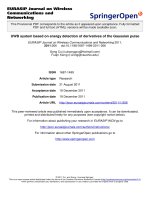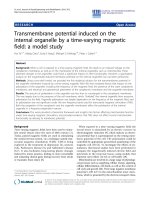Báo cáo hóa học: "Single-photon Transistors Based on the Interaction of an Emitter and Surface Plasmons" docx
Bạn đang xem bản rút gọn của tài liệu. Xem và tải ngay bản đầy đủ của tài liệu tại đây (376.58 KB, 4 trang )
NANO EXPRESS
Single-photon Transistors Based on the Interaction of an Emitter
and Surface Plasmons
Fang-Yu Hong Æ Shi-Jie Xiong
Received: 21 June 2008 / Accepted: 25 August 2008 / Published online: 19 September 2008
Ó to the authors 2008
Abstract A symmetrical approach is suggested (Chang
DE et al. Nat Phys 3:807, 2007) to realize a single-photon
transistor, where the presence (or absence) of a single inci-
dent photon in a ‘gate’ field is sufficient to allow (prevent)
the propagation of a subsequent ‘signal’ photon along the
nanowire, on condition that the ‘gate’ field is symmetrically
incident from both sides of an emitter simultaneously. We
present a scheme for single-photon transistors based on the
strong emitter-surface-plasmon interaction. In this scheme,
coherent absorption of an incoming ‘gate’ photon incident
along a nanotip by an emitter located near the tip of the
nanotip results in a state flip in the emitter, which controls
the subsequent propagation of a ‘signal’ photon in a nano-
wire perpendicular to the axis of the nanotip.
Keywords Single-photon transistor Á Nanotip Á
Surface plasmon
Introduction
The fundamental limit of a photonic transistor [1]isa
single-photon transistor where the propagation of a single
photon in the ‘signal’ field is controlled by the presence or
absence of a single photon in the ‘gate’ field. Such a
nonlinear device may find many interesting applications in
fields such as optical communication [2], optical quantum
computer [3], and quantum-information processing [4].
However, its physical realization is extremely demanding
because photons rarely interact. To achieve strong inter-
action between photons, several schemes based on either
the resonantly enhanced nonlinearities of atomic ensembles
[5–8] or individual atoms coupled to photons in cavity
quantum electrodynamics (CQED) have been proposed [9–
12]. Recently, a robust, practical approach based on the
tight concentration of optical fields associated with guided
surface plasmons (SP) on conducting nanowires has
emerged [13]. However, this scheme works on condition
that the optical ‘gate’ is split into two completely same
parts and having them incident from both sides of the
emitter simultaneously.
In this paper, we present a scheme for a single-photon
transistor consisting of a nanotip, a nanowire, and an
emitter. A single ‘gate’ photon propagating along a nanotip
is coherently stored under the action of a classic control
field, which results in an internal state flip in the emitter.
This conditional state flip can change the propagation of a
subsequent ‘signal’ photon traveling along the nanowire. In
our scheme, the aforesaid condition can be released, the
single ‘gate’ photon is incident from one side of the nanotip
and travels toward the emitter which locates near the tip of
the nanotip.
Recently, as a new scheme to achieve strong coupling
between light and an emitter, surface plasmons which are
propagating electromagnetic modes confined to the surface
of a conductor-dielectric interface, have attracted intensive
interests [13–21]. Surface plasmons can reduce the effec-
tive mode volume V
eff
for the photons, thereby achieving a
substantial increase in the coupling strength g / 1=
ffiffiffiffiffiffiffiffi
V
eff
p
.
An effective Purcell factor P C
pl
=C
0
[ 10
3
in realistic
systems may be achievable according to the theoretical
results in [18, 22], where C
pl
is the spontaneous emission
rate into the surface plasmons (photons) and C
0
describes
contributions from both emission into free space and
F Y. Hong (&) Á S J. Xiong
National Laboratory of Solid State Microstructures
and Department of Physics, Nanjing University,
Nanjing 210093, China
e-mail:
123
Nanoscale Res Lett (2008) 3:361–364
DOI 10.1007/s11671-008-9166-9
non-radiative emission via ohmic losses in the conductor.
Furthermore, this strong coupling is broadband [13].
The propagation of surface plasmons can be signifi-
cantly changed through interaction with a single emitter.
For low incident powers, the reflection coefficient for an
incoming photon of wavevector k is [13, 23]
rðd
k
޼1
1 þC
0
=C
pl
À 2id
k
=C
pl
ð1Þ
and the transmission coefficient t(d
k
) = 1 ? r(d
k
), where
d
k
cjkjÀx
e
. Here, c denotes the group velocity of the
SPs and x
e
is the energy difference between an excited
state jei and a ground state jgi. On resonance, r&-(1-
1/P), and thus the emitter in state jgi works as a nearly
perfect mirror for large P. The bandwidth Dx of the pro-
cess determined by the total spontaneous emission rate C
can be quite large. However, at high incident powers, the
emitter rapidly saturates, as it cannot scatter more than one
photon every time [13]. Two photons directly interact very
weakly, but we can, first, let one photon change the state of
an emitter, and then such change will significantly affect
the propagation of another one. According to this principle
a single-photon transistor may be realized physically [13].
First, we discuss the coherent storage of a single-photon
in an emitter through a nanotip shown in Fig. 1. A three-
level emitter is described by operator r
ij
¼jiihjj (i, j = e,
g, s), with a ground state jgi, a metastable state jsi, and an
exited state jei. The emitter is located along the z-axis of
the nanotip and has a dipole moment p ¼hejerjgi parallel
to the z-axis, which is a necessary condition for the strong
interaction of an emitter and a nanotip [22]. State jsi is
decoupled from the surface plasmons owing to, for exam-
ple, a different orientation of its associated dipole moment
[13], but is resonantly coupled to the excited state jei via
some classical, optical control field X(t) with central fre-
quency x
L
. States jgi and jei are coupled with strength g
via the SP mode with wave vector k which is described by
an annihilation operator a
k
. States jgi; jsi; and jei have the
energy x
g
= 0, x
s
, and x
e
, respectively. The laser light
satisfies the resonance condition: x
L
? x
s
= x
e
. Since the
coupling g is broad-band, it can be assumed to be fre-
quency independent [13, 22]. A linear dispersion relation
x
k
= c|k| is valid provided "hx
k
\2eV[21, 24]. Then,
similar to the Hamiltonian in [13] describing the interaction
of an emitter and a nanowire, the Hamiltonian for our
model can be written in the form
H ¼ x
e
À i
C
0
2
r
ee
þ x
s
r
ss
ÀðXðtÞe
Àitx
L
r
es
þ H:c:Þ
þ
Z
1
À1
dkcjkj a
y
k
a
k
À g
Z
1
À1
dkr
eg
a
k
þ H:c:
0
@
1
A
;
ð2Þ
where the emitter is assumed to be in the origin of the
z-axis and the non-Hermitian term in H describes the decay
of state jei at a rate C
0
into all other possible channels [18].
This effective hamiltonian holds under the condition that
k
B
T ( "hx
e
, e.g., if "hx
e
¼ 1 meV; T\1K; where k
B
is the
Boltzmann constant [13].
The general time-dependent wave function for a system
containing one excitation can be written in the form [13, 26]
jwðtÞi ¼
Z
1
À1
dkc
k
ðtÞ
^
a
y
k
jg; vaciþc
e
ðtÞje; vaci
þ c
s
ðtÞjs; vaci; ð3Þ
where jvaci denotes the vacuum state of the optical field. In
the right-hand side of Eq. 3, the SP propagating toward
(away from) the tip is described by that with k [0(k \ 0).
Under the Hamiltonian given in Eq. 2, the time evolution of
coefficients c
k
(t) and c
e
(t) (in a rotating frame) is described
by the following equations:
_
c
k
ðtÞ¼Àid
k
c
k
ðtÞþigc
e
ðtÞ; ð4Þ
_
c
e
ðtÞ¼À
C
0
2
c
e
ðtÞþiXðtÞc
s
ðtÞþig
Z
1
À1
dkc
k
ðtÞ: ð5Þ
Integrating Eq. 4 yields
c
k
ðtÞ¼c
k
ðÀ1Þe
Àid
k
t
þ ig
Z
t
À1
dt
0
c
e
ðt
0
Þe
Àid
k
ðtÀt
0
Þ
: ð6Þ
Substituting Eq. 6 into Eq. 5, in a way similar to the
Wigner-Weisskopf theory of spontaneous emission [25,
13], we obtain the following equations for the atomic state
amplitudes,
_
c
e
ðtÞ¼iXðtÞc
s
ðtÞÀ
C
pl
þ C
0
2
c
e
ðtÞþi
ffiffiffiffiffiffi
2p
p
gE
in
ðtÞ;
ð7aÞ
_
c
s
ðtÞ¼iX
Ã
ðtÞc
e
ðtÞ; ð7bÞ
where C
pl
¼ 2pg
2
=c is the spontaneous emission rate into
the SP modes and E
in
ðtÞ¼1=
ffiffiffiffiffiffi
2p
p
R
1
À1
dkc
k
ðÀ1Þe
Àid
k
t
¼
Fig. 1 Schematic description of coherent storage of a single photon
(SP) in the system consists of an emitter and a nanotip. The emitter is
initially in the ground state jgi and the dipole moment p of the emitter
is parallel to the axis of the nanotip. Under the action of the control
field X(t) dependent on the wave packet of the incoming photon, the
capture of the incoming single photon may be realized while a state
flip from jgi to jsi is induced
362 Nanoscale Res Lett (2008) 3:361–364
123
1=
ffiffiffiffiffiffi
2p
p
R
1
0
dkc
k
ðÀ1Þe
Àid
k
t
is the incoming single-photon
wave function (in a rotating frame), assuming that c
k
(-?)
= 0ifk \ 0 for the incoming field.
Below we will show that, from Eq. 7, the amplitudes
c
e
(t) and c
s
(t) including the control pulse X(t) can be
expressed in terms of E
in
(t). We assume that the photon
storage process induces no outgoing field at the end, that is
c
k
(?) = 0, which combined with Eq. 6 yields
c
e
ðtÞ¼
icE
in
ðtÞ
ffiffiffiffiffiffi
2p
p
g
: ð8Þ
From Eq. 7, we can solve for the amplitude of c
s
(t):
d
dt
jc
s
ðtÞj
2
¼ cjE
in
ðtÞj
2
À
c
P
jE
in
ðtÞj
2
À
c
C
pl
d
dt
jE
in
ðtÞj
2
; ð9Þ
and the phase of c
s
(t):
dh
dt
¼
i
jc
s
ðtÞj
2
c
e
ðtÞ
d
dt
c
Ã
e
ðtÞþ
C
pl
þ C
0
2
c
Ã
e
ðtÞ
þ i
ffiffiffiffiffiffi
2p
p
gE
Ã
in
ðtÞ
þ
1
2
d
dt
jc
s
ðtÞj
2
!
:
ð10Þ
Then, from Eq. 7b, we can express X(t) in terms of the
amplitudes that have been solved above:
XðtÞ¼i
d
dt
c
Ã
s
ðtÞ
=c
Ã
e
ðtÞ: ð11Þ
Considering that the incoming field vanishes at t =±?
and the normalization condition
R
1
À1
dtjE
in
ðtÞj
2
¼ 1=c, from
Eq. 9, we have |c
s
(?)|
2
= 1-1/P, which is physically
equivalent to the probability for successful photon storage
and spin flip from jgi to jsi. In the numerical simulation of a
single-photon coherent storage (Fig. 2), we assume g ¼
1:6 Â10
10
m
1=2
s
À1
; P ¼ 100; E
in
ðtÞ¼i
ffiffiffiffiffiffiffi
ffiffi
2
p
a
ffiffi
p
p
q
e
Àðct=aÞ
2
m
À1=2
with c = 1.5 9 10
8
m/s [19], a = 0.3 m, and the emitter is
initially in state jgi. When this storage process finished,
c
s
(?) = 0.9950. If the incoming field contains no photon,
the emitter is not affected by the control field X(t) and
remains in state jgi for the whole process. Thus, when the
control field X(t) is turned off, the internal state of the
emitter is jsiðjgiÞ provided the incoming field along the
nanotip containing one (no) photon.
In our scheme for photon transistors, the emitter has
such four energy levels, ground state jgi, metastable state
jsi, and two excited states je
i
i with energy x
i
(i = 1, 2)
that the dipoles p
1
¼he
1
jerjgik
^
/ and p
2
¼he
2
jerjgi?
^
/
shown in Fig. 3, where
^
/ is a unit vector oriented along the
azimuthal axis (while ^z is along the axis of the nanowire
and
^
q is the unit vector oriented radially out). The nanotip
is placed in such a way that the dipole moment p
1
located
along the axis of the nanotip denoted by ^z
t
and oriented
parallel to ^z
t
. We further assume that only the fundamental
surface plasmon mode of the nanotip and nanowire are
excited surface plasmons [22].
In the stage of photon storage, the ‘gate’ photon prop-
agating along the nanotip is on resonant with the transition
jgi!je
1
i and the frequency x
L
of the control field X(t)
satisfies the resonance condition x
L
þ x
s
¼ x
e
1
. In this
stage, the emitter does not excite the fundamental plasmon
mode of the nanowire because p
1
k
^
/ and p
2
is off resonant
with the ‘gate’ field [22]. Thus, the aforesaid storage pro-
tocol can be applied to the system comprising the nanotip,
the nanowire, and the emitter. In the second stage, the
‘signal’ field containing one photon resonant with the
transition jgi!je
2
i propagates along the nanowire. This
field will not excite the fundamental plasmon mode in the
nanotip since p
2
?
^
/ and p
1
is off resonant with the ‘sig-
nal’ field [22]. Thus, the propagating property of SPs can
be used in this situation.
−6 −4 −2 0 2 4 6
−5
0
−6 −4 −2 0 2 4 6
0
0.5
1
−8 −6 −4 −2 0 2 4 6 8
0
50
100
t (ns)
×10
−3
Ω(t) (GHz)
β
e
(t)
β
s
(t)
Fig. 2 Numerical simulation of an coherent storage of a single
photon in the system of an emitter and a nanotip. (a) Amplitudes of
the state c
e1
. (b) Amplitude of the state b
s1
. (c) The control field X(t)
Fig. 3 (Color online) Schematic picture of a single photon transistor.
The nanotip is perpendicular to the nanowire. The emitter has four
energy levels, with dipole moments p
1
k
^
/ and p
2
?
^
/. The single
‘gate’ photon propagating along the nanotip is coherently absorbed
under the action of the control field X(t), which results a state flip
from |gi to |si. This conditional state flip can control the propagation
of the ‘signal’ photon traveling along the nanowire
Nanoscale Res Lett (2008) 3:361–364 363
123
Combining the techniques of state-dependent condi-
tional reflection and single-photon storage, a single-photon
transistor can be realized [13]. First, the emitter is initial-
ized in state jgi. Under the action of the control field X(t),
the presence or absence of a photon in a ‘gate’ pulse with
frequency x
1
traveling along the nanotip flips the internal
state of the emitter to state jsi or remains in state jgi during
the storage process. Then, this conditional flip can control
the propagation of subsequent ‘signal’ photons with fre-
quency x
2
propagating along the nanowire. Thus, the
interaction of subsequent signal pulse and the emitter
depends on the internal state of emitter after the storage. If
the emitter is in the state jgi, the signal field is near,
completely reflected by the emitter. Otherwise, the emitter
is in the state jsi, then the field is near-completely trans-
mitted because jsi does not interact with the surface
plasmon. The storage and conditional spin flip makes the
emitter either highly reflecting or completely transparent
depending on the gate field containing none or one single-
photon. Thus, the presence or absence of a single incident
photon in a ‘gate’ field is sufficient to control the propa-
gation of the subsequent ‘signal’ field, and the system
therefore can serve as an efficient single-photon switcher or
transistor.
As a summary, we have presented a scheme for a single-
photon transistor, where the ‘gate’ field propagates along a
nanotip and the ‘signal’ field travels along a nanowire
perpendicular to the nanotip. A single ‘gate’ photon can
control the propagation of a single ‘signal’ photon through
changing the internal state of an emitter assisted by classic
control field. This transistor may find many important
applications in areas such as efficient single-photon
detection [26] and quantum information science. Based on
this scheme, the controlled-phase gate [9] for photons can
be made; furthermore, a CNOT gate which is a key part of
an optical quantum computer [3] is available. This system
may also be a promising candidate for realizing electro-
magnetically induced transparency-based nonlinear
schemes [5–8].
Acknowledgments This work was supported by the State Key
Programs for Basic Research of China (2005CB623605 and
2006CB921803), and by National Foundation of Natural Science in
China Grant Nos. 10474033 and 60676056.
References
1. R.W. Boyd, in Nonlinear Optics (Academic, New York, 1992)
2. H.M. Gibbs, in Optical Bistability: Controlling Light with Light
(Academic, Orlando, 1985)
3. J.L. O’Brien, Science 318, 1567 (2007)
4. D. Bouwmeester, A. Ekert, A. Zeilinger, in The physics of
Quantum Information (Springer, Berlin, 2000)
5. H. Schmidt, A. Imamoglu, Opt Lett 21, 1936 (1996)
6. S.E. Harris, Y. Yamamoto, Phys. Rev. Lett. 81, 3611 (1998)
7. M.D. Lukin, Rev. Mod. Phys. 75, 457 (2003)
8. M. Fleischauer, A. Imamoglu, J.P. Marangos, Rev. Mod. Phys.
77, 633 (2005)
9. L M. Duan, H.J. Kimble, Phys. Rev. Lett. 92, 127902 (2004)
10. K.M. Birnbaum et al., Nature 436, 87 (2005)
11. E. Waks, J. Vuckovic, Phys. Rev. Lett. 96, 153601 (2006)
12. P. Bermel, A. Rodriguez, S.G. Johnson, J.D. Joannopoulos, M.
Soljac
˘
ic
´
, Phys. Rev. A 74, 043818 (2006)
13. D.E. Chang, A.S. Sørensen, E.A. Demler, M.D. Lukin, Nat. Phys.
3, 807 (2007)
14. L. Childress, A.S. Sørensen, M.D. Lukin, Phys. Rev. A 69,
042302 (2004)
15. A.S. Sørensen et al., Phys. Rev. Lett. 92, 063601 (2004)
16. A. Blais et al., Phys. Rev. A 69, 062320 (2004)
17. A. Wallraff et al., Nature (London) 431, 162 (2004)
18. D.E. Chang, A.S. Sørensen, P.R. Hemmer, M.D. Lukin, Phys.
Rev. Lett. 97, 053002 (2006)
19. Y. Fedutik, V.V. Temnov, O. Scho
¨
ps, U. Woggon, Phys. Rev.
Lett. 99, 136802 (2007)
20. M.I. Stockman, Phys. Rev. Lett. 93, 137404 (2004)
21. C. Ropers, C.C. Neacsu, T. Elsaesser, M. Albrecht, M.B. Ras-
chke, C. Lienau, Nano Lett. 7, 2784 (2007)
22. D.E. Chang, A.S. Sørensen, P.R. Hemmer, M.D. Lukin, Phys.
Rev. B 76, 035420 (2007)
23. J.T. Shen, S. Fan, Opt. Lett. 30, 2001 (2005)
24. G. Schider, J.R. Krenn, A. Hohenau, H. Ditlbacher, A. Leitner,
F.R. Aussenegg, W.L. Schaich, I. Puscasu, B. Monacelli, G.
Boreman, Phys. Rev. B 68, 155427 (2003)
25. P. Meystre, M. Sargent III, in Elements of Quantum Optics, 3rd
edn. (Springer, New York 1999)
26. W. Yao, R B. Liu, L.J. Sham, Phys. Rev. Lett. 95, 030504 (2005)
364 Nanoscale Res Lett (2008) 3:361–364
123









